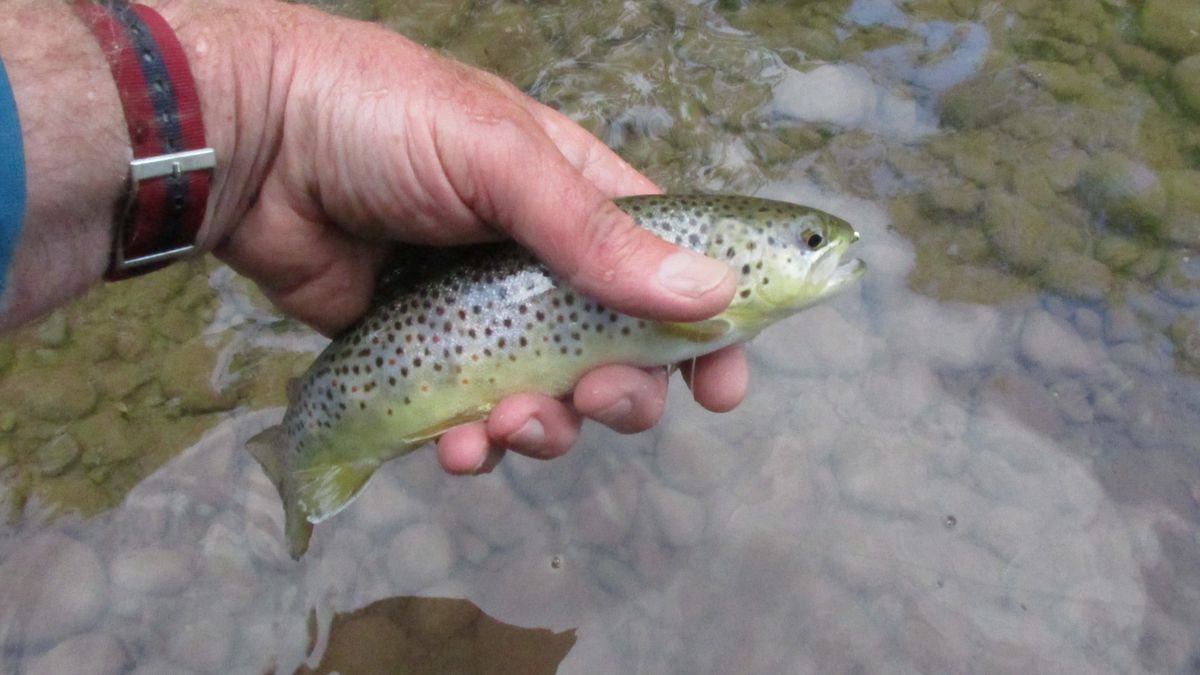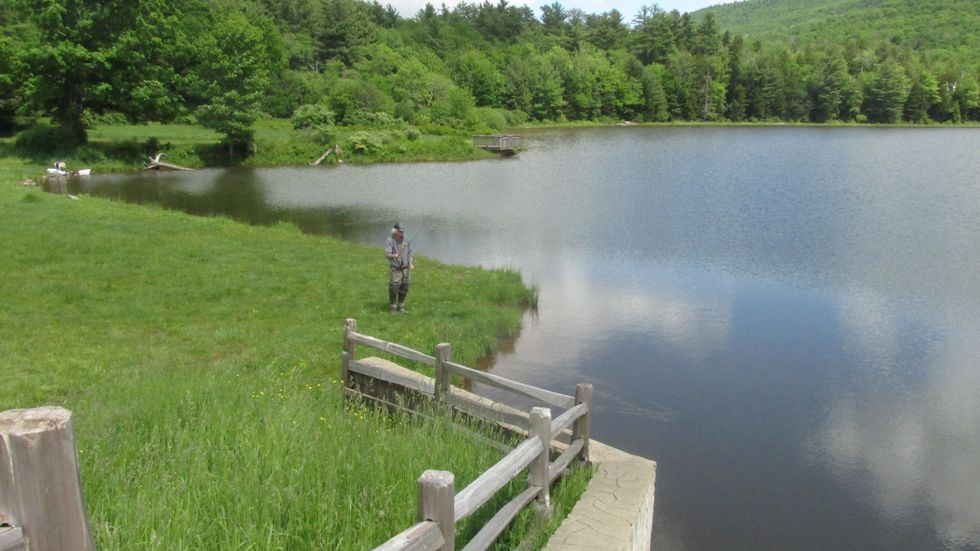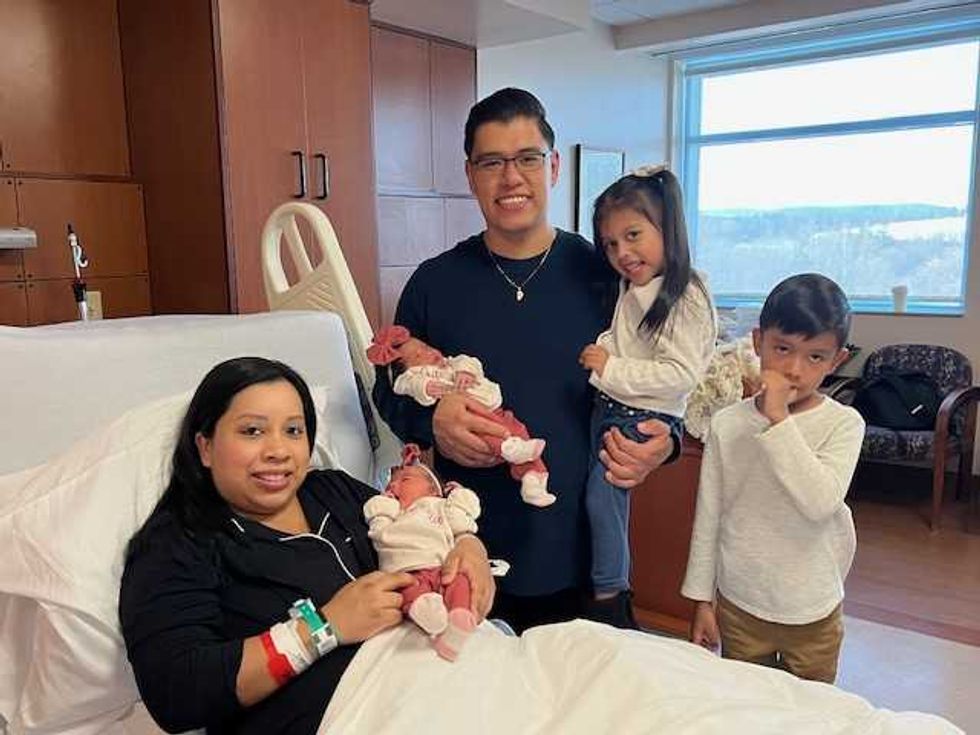Research and development

The catch of the day for the Tangled column of the week.
Patrick L. Sullivan

The catch of the day for the Tangled column of the week.
Fishing trips are rarely straightforward propositions. Over 52 years of flicking the baited hook, I have learned not to make plans with rigid schedules, because something always goes awry.
Last week I traveled deep into the wilds of Greene County, N.Y., for some research and development with my fishing guru Gary.
This meant remembering where his house is.
In that part of the world, there is a Route 23, a Route 23A, and a Route 23C.
I have often wondered why the geniuses that assign numbers to roads couldn’t just call them Route 23, Route 24, and Route 25.
Maybe a sequential clump of numbers is too easily confused. How about Routes 23, 47 and 59?
Luckily Gary’s neighbor has hung a gigantic American flag a couple doors down.
Whoops, there’s the flag, turn around.
R&D project A was a town reservoir. I’m not going to name the town because everything about this adventure was highly irregular.
Acting on intelligence gleaned from unusually reliable sources, we drove past a series of increasingly unpromising signs.
First we were warned to keep out. Then it was no hunting, fishing, trapping or trespassing for any reason. Then the signs returned to the general “keep out” theme.
We finally got to a gate. It was open. There were two men talking about something.
Gary went over to them. He conversed with one. He returned.
“We’re good,” he said. He had been talking to the water supply boss, who said it was fine if we parked outside the gate, out of the way, and walked up.
“It’s only about a quarter mile,” said Gary.
Of course it was mostly uphill, and not a gentle grade, either.
At the midway point, we heard yelping and hollering from the deep woods.
Two men emerged. They did not look outdoorsy. They looked out of shape and frustrated. (I am, after all, a highly trained observer.)
They had lost two chihuahuas. The dogs had been in the woods all night. The plan seemed to be to stumble around the woods in haphazard fashion yelling variations on “Here doggy!”
There didn’t seem to be anything we could do so we soldiered on, eventually reaching a large pond of sorts which was the reservoir that supposedly held big rainbow trout.
We tried, but it was windy and squishy and I was wearing a pair of boat shoes, handy enough in the right context but next to useless here.
I caught two bluegills. Gary caught a shiner.
On the way back the rescue team had located one dog. The other one had gone silent. I suggested opening a can of the ripest dog food available, on the theory the rich scent might overcome the dog’s terror.
The R&D continued at Lake Colgate, which is really more of a pond, created by damming up the East Kill. There is another impoundment about a mile upstream, and in between is a nice-looking bit of stream that should contain brook trout.
There is another impoundment about a mile upstream, and in between is a nice-looking bit of stream that should contain brook trout.
On this day it contained shiners and nothing else.
We tracked it down to where it merges into the lake, and I caught another bluegill which was sitting in about three inches of water making faces at me.
I showed him.

The good thing about riding around with Gary is his catalog of amusing anecdotes and vivid character sketches. Also cigar smoking is allowed.
This time I learned about Cowboy George. A Brooklynite, George found himself in New Mexico, where he developed a taste for garish, stage cowboy attire.
Upon his return to Brooklyn, he developed the theme, with a twist.
George was also a cross-dresser. And a cocaine dealer, with a sideline in illegal guns.
Gary once asked him why he liked dressing like Dale Evans.
“When that buckskin hits my thighs, the years just melt away,” George replied.
Back in Phoenicia, I convened with my nomadic attorney, Thos., who was ensconced at the Woodland Valley Campground nearby.
I’m not sure how we got on the subject, but he explained his “layered defense” for personal protection that does not involve a firearm. His travels take him all over the place, and carrying a gun just isn’t practical for legal reasons.
The first item is pepper spray.
The second is a gas mask. “One of those World War One things, I want it to be terrifying.”
And the third is a spear.
He explained he had returned a custom made spear to the Japanese maker. It wasn’t pointy enough.
“I’d do more damage hitting someone with the handle.”
Thos. further explained that sometimes he finds himself bivouacking in less than ideal circumstances.
Thos. saw “The Texas Chainsaw Massacre” at a tender age, and it left a lasting impression.
One Florida campground reminded him of the film enough that after talking with his new neighbors for five minutes, he got back in the car and left, without unhitching the camper or even stopping at the office to get his 15 bucks back.
Some fishing did get done on this trip.
Woodland Valley Creek is a major Esopus tributary and for 60 years or so, the Woodland Trout Fund (which sports the easily misconstrued acronym WTF), has planted brown and brook trout on Memorial Day weekend with a smaller stocking in July.
There is excellent access to public water downstream, and the WTF has a long-standing arrangement with the homeowners in the valley that trespassing for the purpose of fly-fishing is allowed.
The years have not been kind to the stream. Hurricanes and floods have reconfigured the streambed several times and left exposed clay banks. Forests of knotweed have eliminated cherished pools and runs.
And the new generation of homeowners are not as accommodating as their predecessors.
Nonetheless, it is where I learned to fish, and I always chip in. I try to catch my first Catskill trout of any given year in Woodland, with a bamboo rod and a dry fly.
That didn’t happen this year. I was unfaithful and hit the Beaverkill, Schoharie and a couple of others first.
But I did chuck a Chubby Chernobyl into the pool where my late father caught his last trout, and a feisty brown obliged by smacking it hard.
I used a Phillipson bamboo rod, seven feet for five weight, which my father gave me as a college graduation present.
Other kids got fancy cars, or a seat on the board, or a months-long trip to Europe.
But I’m still using the rod.
So who got the better deal?
Bryan Monge Orellana and Janneth Maribel Panjon Guallpa of Amenia are the parents of Ethan Nicolas Monge Panjon, Sharon Hospital’s first baby of 2026.
SHARON — Sharon Hospital welcomed its first births of the year on Wednesday, Jan. 7.
At 12:53 a.m., Ethan Nicolas Monge Panjon was born to Janneth Maribel Panjon Guallpa and Bryan Monge Orellana of Amenia. He weighed 5 pounds, 10 ounces and measured 20.25 inches long.
Later that morning, twins were born to Belinde and Erick Garcia of New Milford. Gabriella Garcia arrived at 8:17 a.m., weighing 5 pounds, 14 ounces and measuring 19 inches. One minute later, at 8:18 a.m., Isabella Garcia was born weighing 5 pounds, 8 ounces and measuring 18.5 inches.

Area ambulance squad members and several first selectmen attend a Jan. 5 meeting hosted by Nuvance/Northwell to discuss emergency service providers.
FALLS VILLAGE — Paramedic coverage in the Northwest Corner is continuing despite concerns raised last month after Sharon Hospital announced it would not renew its long-standing sponsorship agreement with Northern Dutchess Paramedic.
Northern Dutchess Paramedic (NDP), which has provided advanced life support services in the region for decades, is still responding to calls and will now operate alongside a hospital-based paramedic service being developed by Sharon Hospital, officials said at a public meeting Monday, Jan. 5, at the Falls Village Emergency Services Center.
“We haven’t missed a beat; we’re still taking calls,” said Andrea Downs, president of the Falls Village Volunteer Fire Department and an employee of NDP, speaking at the meeting, which was attended by ambulance squad members, first selectmen and representatives of Sharon Hospital.
Sharon Hospital announced Dec. 11 that it would not renew its annual agreement with NDP, ending a 28-year relationship and initially stating that service would cease Jan. 1. Hospital President and CEO Christina McCulloch said the decision was based on compliance concerns tied to the hospital’s role as sponsor.
“Being a sponsor is a big deal,” McCulloch said. “Our concerns were big enough that we couldn’t sign. It was a difficult decision.”
She said the hospital had discussed the issues with NDP representatives and cited unmet state requirements.
Without a sponsoring hospital, NDP could not operate in Connecticut. That issue was resolved when NDP finalized an agreement with Stamford Hospital, allowing it to continue providing services in the Northwest Corner.
At the same time, Sharon Hospital is establishing a hospital-based paramedic service through Nuvance/Northwell, owner of the hospital. Under the current model, the service consists of a single paramedic, who begins the day at New Milford Hospital before traveling to Sharon, prompting concerns from some volunteer ambulance crews about response times while that paramedic is in transit.
Addressing those concerns, hospital officials said while the new paramedic service covers a wide area, so too does NDP, which is based out of Rhinebeck. Some volunteer ambulance crews also said their concerns relate to the transition to two providers, with Sharon Hospital’s service still being built out and not yet fully stationed in Sharon.
Falls Village First Selectman David Barger asked whether more than one paramedic service could operate in the region.
“There could be more than one,” McCulloch said.
Matt Cassavechia, director of emergency services for Sharon Hospital, said Litchfield County Dispatch, which handles all ambulance and fire dispatching for the region, will call whichever paramedic service is available at the time of an emergency.
He acknowledged that the current arrangement could be improved and said the hospital hopes to expand on-site paramedic coverage in Sharon. Doing so would require state approval through a need-for-service application, which Cassavechia said would benefit from letters of support from the community and area first selectmen.
Several volunteer ambulance representatives expressed concern about how changes could affect basic life support services and volunteer operations. Cassavechia said the hospital does not intend to replace volunteer squads.
“We’re not snapping up patients,” he said. “That’s not what we do. We are deliberate and purposeful. We have zero intent of putting volunteers out of business.”
Questions were also raised about possible delays in transferring patients from Sharon Hospital to other facilities. McCulloch said the hospital has been experiencing high emergency room and inpatient volumes but has not seen unusual wait times.
Michelle Hansen of the Falls Village ambulance squad cited a recent case involving a cancer patient who needed to be transported to Yale New Haven Hospital and was reportedly told by Nuvance that there would be an upfront cost of $2,000. NDP ultimately completed the transport.
“That is certainly not our practice,” said Thomas Horkan, Sharon Hospital’s EMS coordinator. “As soon as we were made aware, we took corrective action. It was human error. I listened to the tape. It was unfortunate.”
State Rep. Maria Horn, D-64, attended the meeting to assess how the changes might affect patient care and costs. Cassavechia said billing practices vary among ambulance providers and that clearer rules of engagement would need to be established with local squads.
After the discussion, Sharon First Selectman Casey Flanagan said the outcome appeared reassuring.
“It seems we’re going to have bonus coverage,” he said. “So, I’m OK with this.”

SHARON — Austin Howard Barney — known simply as “Barney” to many, of Sharon, age 87, died on Dec. 23, after his heroic battle with the black breath, hanahaki disease, cooties, simian flu and feline leukemia finally came to an end.
Austin was born on July 26, 1938, son of Sylvester and Iva Barney.
He leaves behind an overwhelming amount of junk—sorry, treasures. If you’ve ever dreamed of owning a console TV roughly the size of a Buick, a soot-encrusted coffee pot that hasn’t been properly cleaned since the Reagan administration or creatively bent hangers that he had hanging in his living room windows to dry clothes on, give us a call. Please wait for the appropriate, respectful amount of time. Tomorrow should be fine.
Austin was frugal to the extreme; some may have called him “cheap,” but he preferred to think of himself as a pioneer in recycling—decades before it was cool. His kitchen was home to a vast collection of cool whip and country crock containers. The biggest challenge was finding actual cool whip or butter in his refrigerator with all the containers of leftovers that looked the same. “Open at your own risk” was our motto.
He leaves behind a wonderfully dysfunctional family—a group he tolerated, loved and occasionally avoided.
Austin was world-renowned for his lack of patience, grossly excessive extreme sarcasm, not holding back his opinion and knack for telling you exactly how wrong you were. One of his favorite quotes was, “I was only wrong once in my life. I thought I made a mistake.”
He always preferred his own cooking to anyone else’s—and to be fair, it was actually pretty good.
Austin served proudly with the 6th Marines in the United States Marine Corps from Feb. 10, 1958, through Feb. 9, 1962. Semper Fi!
He was also a volunteer fireman for several years, until he realized that sprinting in the opposite direction from fire was more aligned with his personal survival goals.
A natural mountain man, he ate things from the swamp that most people avoid and cooked on a wood stove for many years. He was an avid bird watcher and found joy in feeding all the animals that frequented his property.
He was predeceased by his brothers, Sylvester Barney, Louis Barney and his sister Shirley MacDougall.
He is survived by his daughters Darlene Hardzog, Margaret Gdovin (Mike); his son, Austin Barney Jr. (Kate); his grandchildren, Savannah Hardzog, Jordan Gdovin, Violet Barney, Amethyst Barney and Austin Barney III; and his sister Anita Baird along with various other relatives. You know who you are. He will be greatly missed.
There will be no viewing, as his children refused to comply with his request to be taxidermied and propped in the corner with a beer or a glass of scotch in his hand so guests could admire him in his natural state.
Services are pending and details will be shared at a later date.
In lieu of flowers, donations may be made to the American Red Cross in his memory.
Austin Barney has approved this message. Approval notwithstanding, it would have read the same.
FALLS VILLAGE — Francis J. “Bosco” Schell of Falls Village passed away peacefully on Dec. 20, at East Mountain House in Lakeville surrounded by members of his family.
Born in Kosice, Slovakia, in 1934 to a family of landowners in their ancestral home, he came to the United States in 1947 following the wreckage of the Second World War.
He gained full scholarships to the Montclair Academy in New Jersey and to Williams College in Massachusetts before serving in the US Army in Germany.
Soon after his return to New York City he began work at the Reader’s Digest where he would stay for his entire professional career, starting in Paris at the International Edition, and returning to the US to create Families, and then on to leading the non-US editions of the magazine, the International and global Condensed Books.
He married Natalia Gortchacow in 1962, who predeceased him in 1992, and Page Dickey in 2000. He was devoted to his family and children, and to the huge cohort of friends he kept, who shared his relentless joie de vivre, his love of gardens, music, parties, dancing and drama.
Bosco was deeply involved in charity work, becoming by family tradition a member of the Catholic Sovereign Order of Malta, where he reached the rank of Knight Grand Cross of Honor and Devotion. He worked tirelessly to channel funds and medical equipment to his beloved Hungarians writhing under the Soviet yoke and then in aid of their successful quest for economic and political freedom. He headed the Hungarian Association of the Knights of Malta in Exile which led to the re-creation of the Hungarian Delegation in Hungary.
In his later years, he chaired the board of the David M. Hunt Library in Falls Village where he could be found raising funds by selling cuttings from his own greenhouse along with his legendary home-made jam.
Bosco’s two lifelong passions were gardening and music. Always an enthusiastic dabbler, retirement enabled him to attend the Brooklyn Botanical Gardens where he earned his degree in horticulture in 1997 before settling down with Page in her published garden at Duck Hill in North Salem, NY. They eventually moved to Falls Village in 2015 where they established Church House and its garden. He took great pride in its opening to the public and last gave a virtual tour of his greenhouse in 2021 to benefit charity.
He is remembered by his loving wife Page, his two children Peter Schell and Marie-Elizabeth Offierski and their spouses Blandine and Stefan, his four step-children Keith Dickey, Kim Dickey Ambrose, Scott Dickey and Jean Dickey Quaintance and their spouses Ally, Kirk, Ilia and Don, by his eight grandchildren Irène, Valentine, Anastasia, Paul, Frederic, Conrad, Gregor, and Olga and his six step-grand-children Claire, Helen, Freddy, Charlie, Alex and Keala.
A funeral mass was held at 11:00 a.m. on Jan. 5, 2026, at St. Martin of Tours Church of St. Mary in Lakeville. Burial followed at Sleep Hollow Cemetery in Tarrytown, New York.